Kerala Plus One Zoology Notes Chapter 2 Animal Kingdom
BASIS OF CLASSIFICATION:
The fundamental features used in animal classification are:
- Arrangement of cells
- body symmetry
- nature of coelom
- patterns of digestive
- circulatory or reproductive systems.
Levels of Organisation:
| In sponges, the cells are arranged as loose cell aggregates, i.e. they exhibit cellular level of organisation. Some division of labour (activities) occur among the cells. |
| In Echinoderms and Chordates, organs are associated to form functional systems, it is concerned with a specific physiological function. This is called organ system level of organisation. |
For example, the digestive system in Platyhelminthes has only a single opening to the outside of the body that serves as both mouth and anus, and is hence called incomplete. A complete digestive system has two openings, mouth and anus.
The circulatory system are of two types:
| (i) Open type in which the blood is pumped out of the heart and the cells and tissues are directly bathed in it. (ii) Closed type in which the blood is circulated through a series of vessels of varying diameters (arteries, veins and capillaries). |
Symmetry:
Animals can be categorised on the basis of their symmetry.
| Sponges are asymmetrical, i.e., any plane that passes through the centre does not divide them into equal halves |
| When any plane passing through the central axis of the body divides the organism into two identical halves, it is called radial symmetry. eg: Coelenterates, ctenophores and echinoderms |
| Animals like annelids, arthropods, etc. where the body is divided into identical left and right halves in only one plane, It is called bilateral symmetry. |
Diploblastic and Triploblastic Organisation:
| Animals in which the cells are arranged in two embryonic layers, an external ectoderm and an internal endoderm, are called diploblastic animals, eg: coelenterates. |
| An undifferentiated layer, mesoglea, is present in between the ectoderm and the endoderm. The developing embryo has a third germinal layer, mesoderm, in between the ectoderm and endoderm, they are called triploblastic animals eg: platyhelminthes to chordates |
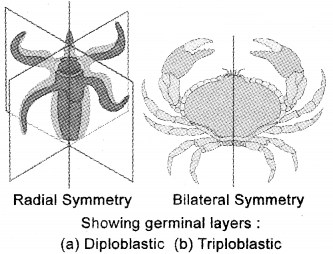
Coelom:
The body cavity, which is lined by mesoderm is called coelom. Animals possessing coelom are called coelomates e.g.annelids, molluscs, arthropods, echinoderms, hemichordates and chordates. In some animals, the body cavity is not lined by mesoderm, instead, the mesoderm is present as scattered pouches in between the ectoderm and endoderm.
Such animals are called pseudocoelomates, eg: aschelminthes. The animals in which the body cavity is absent are called acoelomates, eg: platyhelminthes
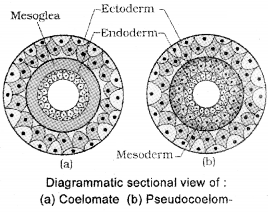
Segmentation:
| In some animals, the body is externally and internally divided into segments. For example, in earthworm, the body shows this pattern called metameric segmentation and the phenomenon is known as metamerism. |
Notochord:
Notochord is a mesodermally derived rod-like structure formed on the dorsal side during embryonic development in some animals. Animals with notochord are called chordates and those animals which do not form this structure are called non-chordates, eg: porifera to echinoderms.
CLASSIFICATION OF ANIMALS:

Phylum – Porifera:
Members are commonly Known as sponges. They are marine and asymmetrical animals. These are primitive multicellular animals and have cellular level of organisation.
- Sponges have a water transport or canal system. Water enters through minute pores (ostia) in the body wall into a central cavity, spongocoel (Choanocytes or collar cells line the spongocoel and the canals), from where it goes out through the osculum.
- This pathway of water transport is helpful in food gathering, respiratory exchange and removal of waste.
- Digestion is intracellular. The body is supported by a skeleton made up of spicules or spongin fibres.
- Sexes are not separate (hermaphrodite)
- Sponges reproduce asexually by fragmentation
- Fertilisation is internal and development include larval stage which is.morphologically distinct from the adult.
Examples: Sycon (Scypha), Spongilla (Fresh water sponge) and Euspongia (Bath sponge).

Phylum – Coelenterata (Cnidaria):
They are aquatic, marine and radially symmetrical animals
1. The name cnidaria is derived from the cnidoblasts or cnidocytes present on the tentacles and the body. Cnidoblasts are used for anchorage, defense and for the capture of prey.
2. Cnidarians are dipioblastic animals. They have a central gastrovascular cavity with a single opening, hypostome.
3. Digestion is extracellular and intracellular. For example , corals have a skeleton composed of calcium carbonate.
4. Cnidarians exhibit two basic body forms called polyp and medusa
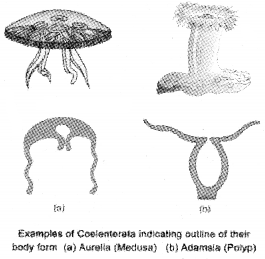
Structure of polyp and medusa:
Polyps are sessile and cylindrical form eg: Hydra, Adamsia, etc. whereas, medusa are umbrella-shaped and free-swimming like Aurelia or jelly fish. They exhibit alternation of generation (Metagenesis), i.e. polyps produce medusae asexually and medusae form the polyps sexually (eg: Obelia).
Examples: Physalia (Portuguese man-of-war), Adamsia (Sea anemone),Pennatula (Sea-pen), Gorgonia (Sea-fan) and Meandrina (Brain coral).
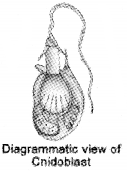
Phylum – Ctenophora:
They incude sea walnuts or comb jellies are marine, radially symmetrical, dipioblastic organisms with tissue level of organisation.
- The body bears eight external rows of ciliated comb plates, which help in locomotion
- Digestion is both extracellular and intracellular.
- Bioluminescence is well-marked in ctenophores.
- Sexes are not separate. Reproduction takes place only by sexual means.
- Fertilisation is external with indirect development.
Examples: pleurobrachia and ctenoplana.

Phylum – Platyhelminthes:
- They have flattened body and called as flatworms
- Flatworms are bilaterally symmetrical, triploblastic and acoelomate animals with organ level of organisation.
- Hooks and suckers are present in the parasitic forms. Some of them absorb nutrients from the host directly through their body surface.
- Specialised cells called flame cells help in osmoregulation and excretion.
- Sexes are not separate.
- Fertilisation is internal and development is through many larval stages. Some members like Planaria possess high regeneration capacity.
Examples: (a) Taenia (Tapeworm), (b) Fasciola (Liver fluke).
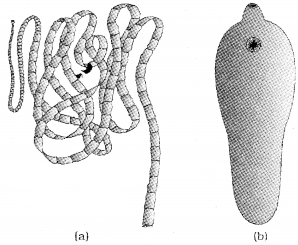
Phylum – Aschelminthes:
The body is circular and called as roundworms. They may be freeliving, aquatic and terrestrial or parasitic in plants and animals.
- Roundworms have organ-system level of body organisation.
- They are bilaterally symmetrical, triploblastic and pseudocoelomate animals.
- Alimentary canal is complete and called as muscular pharynx. An excretory tube removes body wastes from the body cavity through the excretory pore.
- Sexes are separate (dioecious)
- Fertilisation is internal and development may be direct or indirect.
Examples Ascaris (Round Worm), Wuchereria (Filaria worm), Ancylostoma (Hookworm).

Phylum – Annelida:
They may be aquatic (marine and fresh water) orterrestrial; free-living, and sometimes parasitic.
- They exhibit organ-system level of body organisation and bilateral symmetry. They are triploblastic, metamerically segmented and coelomate animals.
- Their body surface is distinctly marked out into segments or metameres and hence, the phylum called as Annelida.
- Aquatic annelids like Nereis possess lateral appendages, parapodia, which help in swimming.
- A closed circulatory system is present.
- Nephridia help in osmoregulation and excretion.
- Neural system consists of paired ganglia connected by lateral nerves to a double ventral nerve cord.
- Nereis, an aquatic form, is dioecious, but earthworms and leeches are monoecious.
- Reproduction is sexual. Examples: Nereis, Pheretima (Earthworm) and Hirudinaria (Blood sucking leech).
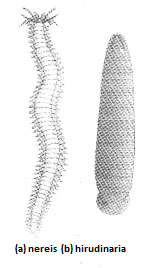
Phylum – Arthropoda:
This is the largest phylum includes insects.
- They have organ-system level of organisation.
- They are bilaterally symmetrical, triploblastic. segmented and coelomate animals.
- The body of arthropods is covered by chitinous exoskeleton.
- The body consists of head, thoraxand abdomen. They have jointed appendages (arthros-joint, poda-appendages).
- Respiratory organs are gills, book gills, book lungs or tracheal system.
- Circulatory system is of open type. Sensory organs like antennae, eyes (compound and simple),
- statocysts or balance organs are present.
- Excretion takes place through malpighian tubules. They are mostly dioecious.
- Fertilisation is usually internal.
- They are mostly oviparous.
Example:
- Economically important insects: Apis (Honey bee), Bombyx (Silkworm), Laccifer(Lac insect)
- Vectors: Anopheles, Culexand Aedes(Mosquitoes)
- Gregarious pest: Locusta (Locust)
- Living fossil: Limulus (King crab).
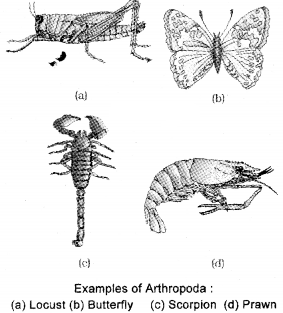
Phylum – Mollusca:
This is the second largest animal phylum
- Molluscs are terrestrial or aquatic (marine or freshwater) having an organ- system level of organisation.
- They are bilaterally symmetrical, triploblastic and coelomate animals.
- Body is covered by a calcareous shell and is unsegmented with a distinct head, muscular foot and visceral hump.
- The space between the hump and the mantle is called the mantle cavity in which feather-like gills are present. They have respiratory and excretory functions.
- The anterior head region has sensory tentacles. The mouth contains a file¬like rasping organ for feeding, called radula.
- They are usually dioecious and oviparous with indirect development.
Examples: Pila (Apple snail), Pinctada (Pearl oyster), Sepia (Cuttlefish), Loligo (Squid), Octopus (Devil fish), Aplysia (Seahare), Dentalium (Tusk shell) and Chaetopleura (Chiton).

Phylum – Echinodermata:
- These animals have an endoskeleton of calcareous ossicles,
- All are marine with organ-system level of organisation.
- The adult echinoderms are radially symmetrical but larvae are bilaterally symmetrical.
- They shows water vascular system which helps in locomotion, capture and transport of food and respiration.
- They are triploblastic and coelomate animals.
- Digestive system is complete with mouth on the lower (ventral) side and anus on the upper (dorsal) side.
- An excretory system is absent. Sexes are separate.
- (Reproduction is sexual. Fertilisation is usually external.
- Development is indirect with free-swimming larva.
Examples: Asterias (Starfish), Echinus (Sea urchin), Antedon (Sea lily), Cucumaria (Sea cucumber) and Ophiura (Brittle star).

Phylum – Hemichordata:
Hemichordata is placed as a separate phylum under non-chordata.
- This phylum consists of a small group of worm-like marine animals with organ-system level of organisation.
- They are bilaterally symmetrical, triploblastic and coelomate animals.
- The body is cylindrical and is composed of an anterior proboscis, a collar and a long trunk.
- Circulatory system is of open type.
- Respiration takes place through gills.
- Excretory organ is proboscis gland. Sexes are separate.
- Fertilisation is external. Development is indirect. Examples: Balanoglossus and Saccoglossus.

Phylum – Chordata:
It is characterised by the presence of a notochord, a dorsal hollow nerve cord and paired pharyngeal gill slits These are bilaterally symmetrical, triploblastic, coelomate with organ- system level of organisation. They possess a post anal tail and a closed circulatory system.
Comparison of Chordates and IMon-chordates:

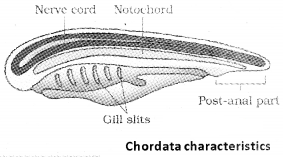
Phylum Chordata is divided into three subphyla:
- Urochordata or Tunicata
- Cephalochordata &
- Vertebrata.
Subphyla Urochordata and Cephalochordata are often referred to as protochordates and are exclusively marine. In Urochordata, notochord is present only in larval tail, while in Cephalochordata, it extends from head to tail region. Examples: Urochordata – Ascidia, Salpa.Doliolum; Cephalochordata – Branchiostoma (Amphioxus or Lancelet).
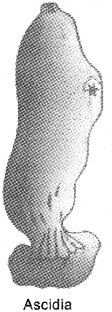
All vertebrates are chordates but all chordates are not vertebrates.why?
The members of subphylum Vertebrata possess notochord during the embryonic period. The notochord is replaced by a cartilaginous or bony vertebral column in the adult. Thus all vertebrates are chordates but all chordates are not vertebrates.
Vertebrates have a ventral muscular heart with two, three or four chambers, kidneys for excretion and osmoregulation and paired appendages which may be fins or limbs.
The subphylum Vertebrata is further divided as follows:

Class – Cyclostomata:
- All living members of the class Cyclostomata are ectoparasites on some fishes. They have gill slits for respiration.
- Cyclosiomes have a sucking and circular mouth without jaws
- Their body is devoid of scales and paired fins
- Cranium and vertebra! column are cartilaginous. Circulation is of closed type.
- Cyclostomes are marine but migrate for spawning to freshwater. After spawning, within a few days, they die. Their larvae, after metamorphosis, return to the ocean.
Examples: Petromyzon (Lamprey) and Myxine (Hagfish).

Class – Chondrichthyes:
- have cartilaginous endoskeleton Mouth is located ventrally.
- Notochord is persistent throughout life.
- Gil! slits are separate and without operculum (gill cover).
- The skin is tough, containing minute placoid scales.
- Teeth are modified placoid scales
- These animals are predaceous.
- Due to the absence of air bladder, they have to swim constantly to avoid sinking.
- Heart is two-chambered (one auricle and one ventricle). ,
- Some of them have electric organs (e.g., Torpedo) and some possess poison sting (e g., Trygon).
- They are cold-blooded (poikilothermous) animals, i.e., they lack the capacity to regulate their body temperature.
- Sexes are separate.
- In males pelvic fins bearclaspers.
- They have internal fertilisation and many of them are viviparous.
Examples: Scoliodon (Dog fish), Pristis (Sawfish), Carcharodon (Great white shark), Trygon (Sting ray).
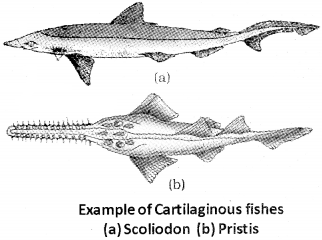
Class- Osteichthyes:
It includes both marine and fresh water fishes with bony endoskeleton.
- They have four pairs of gills which are covered by an operculum on each side.
- Skin is covered with cycloid/ctenoid scales.
- Air bladder is present which regulates buoyancy.
- Heart is two chambered (one auricle and one ventricle).
- They are cold-blooded animals. Sexes are separate.
- Fertilisation is usually external.
- They are mostly oviparous and development is direct.
Examples: Marine – Exocoetus (Flying fish), Hippocampus (Sea horse); Freshwater – Labeo Rohu), Catla (Katla), Clarias (Magur); Aquarium – Betta (Fighting fish), Pterophyllum (Angel fish).

Class – Amphibia:
Amphibians can live in aquatic as well as terrestrial habitats.
- Most of them have two pairs of limbs. Body is divisible into head and trunk.
- The amphibian skin is moist (without scales). The eyes have eyelids.
- A tympanum represents the ear.
- Alimentary canal, urinary and reproductive tracts open into a common chamber called cloaca which opens to the exterior.
- Respiration is by gills, lungs and through skin.
- The heart is three chambered (two auricles and one ventricle).
- These are cold-blooded animals.
- Sexes are separate. Fertilisation is external.
- They are oviparous and development is direct or indirect.
Examples: Bufo (Toad), Rana (Frog), Hyla (Tree frog), Salamandra (Salamander), Ichthyophis (Limbless amphibia).

Class-Reptilia:
The class name represents crawling mode of locomotion.(Latin, repere or reptum, to creep or crawl).
- They are mostly terrestrial animals and their body is covered by dry and cornified skin, epidermal scales or scutes.
- They do not have external ear openings.
- Tympanum represents ear.
- Heart is usually three-chambered, but four-chambered in crocodiles.
- Reptiles are poikilotherms.
- Snakes and lizards shed their scales as skin cast.
- Sexes are separate. Fertilisation is internal.
- They are oviparous and development is direct.
Examples: Chelone (Turtle), Testudo (Tortoise), Chameleon (Tree lizard),Calotes (Garden lizard), Crocodilus (Crocodile), Alligator (Alligator). Hemidactylus (Wall lizard), Poisonous snakes – Naja (Cobra), Bangarus (Krait), Vipera (Viper).

Class-Aves:
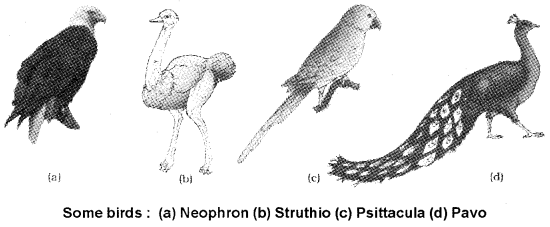
The characteristic features of Aves (birds) are:
- The forelimbs are modified into wings.
- They possess beak
- The hind limbs have scales and are modified for walking, swimming or clasping the tree branches.
- Skin is dry without glands except the oil gland at the base of the tail.
- Endoskeleton is fully ossified (bony) and the long bones are hollow with air cavities (pneumatic).
- The digestive tract of birds has additional chambers, the crop and gizzard.
- Heart is completely four chambered.
- They are warm-blooded (homoiothermic) animals, i.e.,they are able to maintain a constant body temperature.
- Respiration is by lungs.
- Air sacs connected to lungs supplement respiration.
- sexes are separate. Fertilisation is internal.
- They are oviparous and development is direct.
Example: Corvus (Crow), Columba (Pigeon), Psittacula (Parrot), Struthio (Ostrich), Pavo (Peacock), modytes (Penguin), Neophron (Vulture).
Class – Mammalia:
- 1. The characteristic is the presence of milk producing glands (mammary glands) They have two pairs of limbs, adapted for walking, running, climbing, burrowing, swimming or flying
- The skin of mammals is unique in possessing hair
- extemal ears or pinnae are present.
- Different types of teeth are present in the jaw.
- Heart is four chambered. They are homoiothermous.
- Respiration is by lungs. Sexes are separate and fertilisation is internal.
- They are viviparous with few exceptions and development is direct.
Examples: Oviparous – Ornithorhynchus{Platypus)\Viviparous – Macropus (Kangaroo), Pteropus (Flying fox), Camelus (Camel), Macaca(Monkey), Rattus (Rat), Canis (Dog), Fells (Cat), Elephas (Elephant), Equus (Horse), Delphinus (Common dolphin), Balaenoptera (Blue whale), Panthera tigris(Tiger), Panthera leo(Lion).

